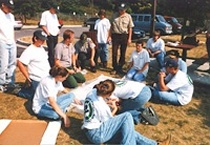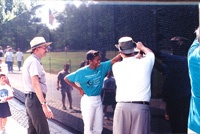|
|
Reinvention principles that apply to this story
Links
related to this story:
AfterSchool Internet Site
|
|
|
Home
Alone
It is 3:00 p.m. on a school day. Do you know where your children
are?
Because of work or other obligations,
some parents simply canít supervise their school-aged children
during non-school hours. As a result, at least 5 million children,
and as many as 15 million, are left home alone each week.
The
Importance of Supervision
Leaving
children alone can be costly.  Studies by the FBI and youth advocacy
groups show that from 2:00 p.m. to 8:00 p.m. on school days, when
supervision is scarcest, children are most likely to commit or
be victimized by crimes. Unsupervised children are more likely
to use alcohol, drugs, and tobacco, get poor grades, and drop
out of school
than children who participate in supervised, constructive after-school
activities. Studies by the FBI and youth advocacy
groups show that from 2:00 p.m. to 8:00 p.m. on school days, when
supervision is scarcest, children are most likely to commit or
be victimized by crimes. Unsupervised children are more likely
to use alcohol, drugs, and tobacco, get poor grades, and drop
out of school
than children who participate in supervised, constructive after-school
activities.
How is the Federal Government Helping?
The Federal government canít provide individual after-school supervision
for every child, but the government is helping to keep kids off
the streets and out of trouble by supporting after-school programs
across the country. In 1998, Congress expanded the National School Lunch Program to cover the costs
of snacks provided by after-school programs located in poor areas. In 1999,
the Federal government awarded $93 million in new grants to help
176 communities establish and improve 21st Century
Community Learning Centers: school buildings kept open and staffed
after regular school hours for activities like literacy education,
recreation, tutoring, and technology education. In addition, government-supported
facilities such as national parks, gardens, historic sites, and
research and computer laboratories now offer interesting and exciting
opportunities to school-aged children.
provided by after-school programs located in poor areas. In 1999,
the Federal government awarded $93 million in new grants to help
176 communities establish and improve 21st Century
Community Learning Centers: school buildings kept open and staffed
after regular school hours for activities like literacy education,
recreation, tutoring, and technology education. In addition, government-supported
facilities such as national parks, gardens, historic sites, and
research and computer laboratories now offer interesting and exciting
opportunities to school-aged children.
|
"For
working parents worried about what their children are
doing after school, and for children who too often get
in trouble in the after-school hours, these activities
are critical. And, itís not just for the peace of mind
of a worried and overworked parent. Itís also for the
learning opportunities available to our children. This
initiative will help communities expand high-quality after-school
programs so that young people can expand their horizons
of creativity, receive one-on-one mentoring and tutoring,
use computers, and learn skills they will need to compete
and win in the 21st Century. This initiative
will get existing resources to communities and kids that
need them."
Vice
President Al Gore
September
13, 1999 |
At Harperís
Ferry in West Virginia, teenagers in the Youth Conservation
Corps dress in Civil War-era costumes and lead guided tours.
In Washington, DC, pre- teens
in the National Park Serviceís Junior Ranger Program introduce
visitors to the Vietnam Memorial. "I have seen these programs
really change young people, particularly those from the inner
city," observes Ramie Lynch, the National Park Serviceís
Youth Programs Coordinator for the National Capital Region.
"And, the children who participate in these after-
school programs also appreciate them." Take the St. Louis,
Missouri middle-school student who attended a government-sponsored
summer program and said, "This project made me feel really good
about myself." teens
in the National Park Serviceís Junior Ranger Program introduce
visitors to the Vietnam Memorial. "I have seen these programs
really change young people, particularly those from the inner
city," observes Ramie Lynch, the National Park Serviceís
Youth Programs Coordinator for the National Capital Region.
"And, the children who participate in these after-
school programs also appreciate them." Take the St. Louis,
Missouri middle-school student who attended a government-sponsored
summer program and said, "This project made me feel really good
about myself."
Spreading
the Word
Itís
likely that more children would take advantage of, and benefit from,
Federal after-school resources if their community leaders, teachers,
school administrators, and parents knew about them. "Many
parents, and people who run after school programs, have no idea
about the availability of Federal resources for after-school programs,
which range from providing mentors to after-school snacks. The
information was hard to find and hard to use, " according
to former teacher, Felicia Wong.
But times have changed. Today, Vice President Goreís National
Partnership for Reinventing Government (NPR), the Federal Executive
Boards, and 17 Federal departments and agencies are partners in
the Federal Support for Communities Initiative. And, theyíre spreading
the word about after-school resources and programs.
Under
this initiative, 15 cities and one state are holding After-School
Resource Fairs where parents, care providers, teachers, and interested
community members will meet representatives from many Federal
agencies and non-profit organizations to learn more about programs
and offerings that can assist children and youth. In addition,
the NPR is consolidating information about available resources,
including more than 100 grant programs for after-school programs
and one-stop access to helpful Federal publications. All of this
information, and more, can be found at the new AfterSchool Internet Site, supported by the General Services
Administration, with assistance from The Finance Project, a nonprofit
organization. Here, kids and teens also will find links to many
safe, fun, and enriching government Internet sites that let them
do everything from building their own Galileo spacecraft to learning
about Jake, a Labrador Retriever that works for the FBI.
For
more information about government-sponsored after-school programs
and resources, visit the AfterSchool Internet Site, or contact Pamela
Johnson at (202) 694-0011.
10/6/99
Home |
Privacy |
Contents |
Comments |
Email Me |
Search
|